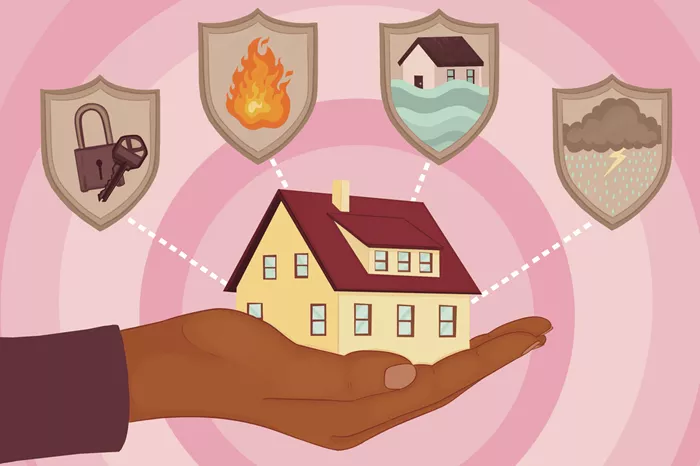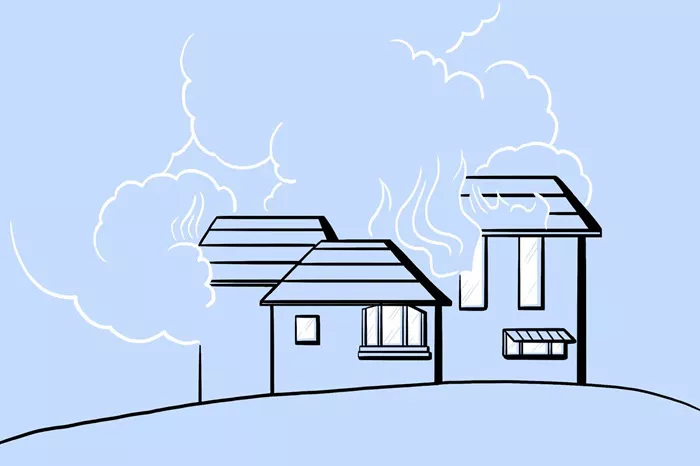Choosing the right home insurance policy is crucial for protecting your property and personal belongings. When deciding what to look for with home insurance, it’s important to thoroughly understand the various types of coverage, policy details, and providers available. This article will guide you through the essential aspects to consider to ensure you select a policy that offers comprehensive protection and suits your needs.
Types of Home Insurance Coverage
1. Dwelling Coverage
Dwelling coverage is the core component of any home insurance policy. It protects the structure of your home from risks such as:
Fire
Windstorm
Hail
Vandalism
Theft
This coverage ensures that if your home is damaged or destroyed, the insurance company will help pay for repairs or reconstruction.
2. Personal Property Coverage
Personal property coverage safeguards your belongings inside the home, including:
Furniture
Electronics
Clothing
Appliances
This type of coverage extends to losses due to risks such as:
Theft
Fire
Water damage
Make sure to evaluate the total value of your possessions to ensure adequate coverage.
3. Liability Coverage
Liability coverage provides protection in the event of legal claims against you for:
Injuries occurring on your property
Damage caused to someone else’s property
It covers legal costs, medical expenses, and potential settlements, protecting your financial assets from lawsuits.
4. Additional Living Expenses (ALE)
If your home becomes uninhabitable due to a covered event, ALE coverage helps with:
Temporary housing
Food expenses
Other necessary living costs
This ensures that you can maintain a normal standard of living while your home is being repaired.
5. Optional Coverages
Consider adding optional coverages based on specific risks, such as:
Flood Insurance: Essential if you live in a flood-prone area.
Earthquake Insurance: Important for regions with seismic activity.
Umbrella Insurance: Provides additional liability coverage beyond standard policy limits.
Evaluating Coverage Limits
1. Replacement Cost vs. Actual Cash Value
Understanding the difference between replacement cost and actual cash value is crucial:
Replacement Cost: Covers the full cost of repairing or replacing damaged items without deducting for depreciation.
Actual Cash Value: Pays for replacement minus depreciation, which may result in lower compensation.
Choose the type of coverage that best suits your needs and budget.
2. High-Value Items Coverage
Check if your policy provides adequate coverage for high-value items such as:
Jewelry
Artworks
Collectibles
Standard policies may have limits on these items, so consider adding riders or endorsements for full coverage.
3. Deductibles
The deductible is the amount you pay out of pocket before insurance coverage kicks in. Factors to consider include:
Higher Deductibles: Lower premiums but higher out-of-pocket costs.
Lower Deductibles: Higher premiums but reduced out-of-pocket costs.
Choose a deductible that balances affordability with the level of protection you need.
Assessing Policy Exclusions
1. Common Exclusions
Understand common policy exclusions to identify potential gaps in coverage:
Termite Damage: Often excluded from standard policies.
Wear and Tear: Not covered as it is considered a maintenance issue.
Neglect: Damage resulting from neglect is typically excluded.
2. Special Risks
Evaluate coverage for special risks that may not be included in a standard policy, such as:
Flood Risks: Not covered under standard policies, requiring separate flood insurance.
Earthquake Risks: May need additional coverage if you live in an earthquake-prone area.
3. Natural Disasters
Ensure your policy addresses the risks associated with natural disasters specific to your location, such as:
Hurricanes
Tornadoes
Wildfires
Understanding Policy Terms and Conditions
1. Policy Declarations Page
Review the policy declarations page, which provides:
Coverage Limits: Maximum amounts your insurer will pay for various types of claims.
Deductibles: Amounts you must pay out of pocket before insurance coverage applies.
Premiums: The cost of your policy.
Ensure all details are accurate and meet your expectations.
2. Policy Endorsements
Endorsements are modifications to your policy that can add or exclude specific coverage. Types to consider include:
Scheduled Personal Property Endorsement: Adds coverage for high-value items.
Home Business Endorsement: Covers business-related risks if you operate a business from home.
3. Renewal and Cancellation Terms
Understand the terms related to policy renewal and cancellation, including:
Automatic Renewal: Policies may renew automatically unless you cancel.
Cancellation Terms: Review conditions under which the insurer or you can cancel the policy.
See Also: What Insurance Do I Need as a Homeowner?
Comparing Insurance Providers
1. Financial Stability
Research the financial stability of insurance providers to ensure they can fulfill their claims obligations. Check ratings from:
A.M. Best
Standard & Poor’s
Moody’s
These ratings provide insight into the insurer’s ability to pay claims.
2. Customer Service
Evaluate the customer service reputation of potential insurers by:
Reading Reviews: Look for feedback from current and past policyholders.
Assessing Responsiveness: Evaluate how quickly the insurer handles claims and inquiries.
3. Claims Process
Investigate the claims process of different insurance providers, including:
Ease of Filing: The process should be straightforward and user-friendly.
Claim Settlement Time: Ensure the insurer processes and settles claims promptly.
Cost Considerations
1. Premium Costs
Compare premium costs among different insurance providers. Factors affecting premiums include:
Coverage Limits: Higher limits generally lead to higher premiums.
Deductibles: Higher deductibles may lower premiums.
Discounts: Availability of discounts for security features, bundling policies, etc.
2. Discounts and Savings
Inquire about available discounts and savings opportunities, such as:
Security System Discounts: Reductions for installing security systems or smoke detectors.
Bundling Discounts: Savings for purchasing multiple policies from the same provider.
3. Cost-Benefit Analysis
Perform a cost-benefit analysis to ensure that the policy provides value for money. Consider:
Coverage vs. Premium: Assess whether the coverage justifies the premium cost.
Policy Benefits: Weigh the benefits provided against the cost of the policy.
Conclusion
Selecting the right home insurance policy involves careful consideration of coverage types, limits, exclusions, and costs. By understanding what to look for with home insurance, you can make an informed decision that ensures your home and belongings are adequately protected. Regularly review your policy to keep up with any changes in your coverage needs and adjust as necessary.
FAQs
1. What does home insurance typically cover?
Home insurance generally covers several key areas, including dwelling coverage for structural damage to your home, personal property coverage for your belongings, and liability coverage for legal claims against you. It may also include additional living expenses if your home becomes uninhabitable. Coverage can vary depending on the policy, so it’s essential to review your policy details to understand what is included. For example, some policies might offer additional coverage for natural disasters like earthquakes or floods, which are typically not included in standard policies. Be sure to check if any optional coverages are available that might fit your specific needs.
2. How can I determine the right amount of coverage for my home?
Determining the right amount of coverage involves assessing the value of your home and personal property. Start by calculating the cost to rebuild your home, including materials and labor, as this is typically covered under dwelling coverage. Next, make an inventory of your belongings and estimate their value to ensure adequate personal property coverage. Consider any high-value items that may require additional coverage through endorsements. It’s also wise to factor in potential additional living expenses if you need temporary housing during repairs. Consulting with an insurance agent can provide personalized guidance based on your specific circumstances.
3. Are there any common exclusions in home insurance policies?
Yes, home insurance policies often have common exclusions that are important to understand. These may include damage from termites, general wear and tear, and neglect of property maintenance. Standard policies might also exclude coverage for certain natural disasters, such as floods or earthquakes, requiring separate policies for these risks. Other exclusions can include intentional damage or damage caused by war. It’s crucial to read your policy carefully and inquire about these exclusions to ensure you’re aware of what is not covered and to consider additional coverage if needed.
4. How do deductibles affect my home insurance policy?
Deductibles are the amounts you must pay out of pocket before your insurance coverage applies to a claim. A higher deductible generally means lower premium costs but requires you to pay more out of pocket if a claim is filed. Conversely, a lower deductible results in higher premiums but reduces your out-of-pocket expenses when making a claim. When selecting a deductible, balance your ability to pay out of pocket with the cost of your premium. Consider how frequently you might need to make a claim and choose a deductible that aligns with your financial situation and risk tolerance.
5. What should I consider when comparing different home insurance providers?
When comparing home insurance providers, consider several factors to ensure you choose the best option for your needs. Evaluate the financial stability of the provider by checking ratings from agencies like A.M. Best or Standard & Poor’s to ensure they can meet their claims obligations. Review customer service ratings and feedback to gauge the insurer’s responsiveness and service quality. Investigate the claims process to ensure it is straightforward and efficient. Compare coverage options, limits, and premiums to find a policy that offers comprehensive protection at a competitive price. Additionally, inquire about available discounts that may reduce your overall premium costs.






















